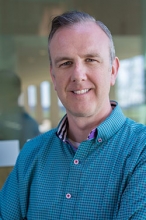Trevor Hirst Embraces California and the Creativity of His Job
 Trevor Hirst describes himself as a Californian trapped in a British person’s body.
Trevor Hirst describes himself as a Californian trapped in a British person’s body.
That’s not his official job title, of course. But it fits, considering he moved to the West Coast from Great Britain without ever having visited, and jumped right into a job in graduate and undergraduate research programs at UC Santa Barbara, where his wife, Professor Linda Hirst, had already been hired.
He said he vastly prefers the warmer, sunnier climate here to the United Kingdom's typically overcast skies, and wouldn't want to move back.
He definitely wouldn’t want to trade for his former career as a lawyer in England, either.
“I feel like the line of work I’ve found myself in is a lot more creative than being a lawyer was,” Hirst said. “I still have to fill out forms and deal with regulations, but this job just doesn’t have that constant, intense pressure that being a lawyer does.”
The Hirsts met at the University of Manchester, England, and, after living in Santa Barbara and Tallahassee, Fla., came to Merced in 2008, when Linda Hirst joined the School of Natural Sciences to study soft matter and biophysics.
An accompanying spouse, Trevor started working at UC Merced in 2009, running the Center of Excellence on Health Disparities. Since then, the center has become a research cluster under the auspices of the Health Sciences Research Institute (HSRI). Trevor is now HSRI’s executive director, helping its more than 75 affiliated faculty members get money for their research.
In his spare time, Trevor Hirst is an accomplished photographer and provided the photographs and illustrations for his wife’s book, “The Fundamentals of Soft Matter Science.” He’s an audiophile with an eclectic taste in music and an extensive collection of vinyl and CDs, and is an avid hiker in the Sierra Nevada and Yosemite and Pinnacles national parks.
Please describe what your job entails.
I look at HSRI like an ad agency. The director, Professor Paul Brown, is the head of creative, and I’m the business person. He works with the faculty and the community to come up with big ideas, and I work out how to make them work. I help faculty members get funding, and if we’re going to work with community partners, I work with their business people to make sure the partnership is beneficial to both institutions. I also manage communications for HSRI.
We’re a one-stop shop for the faculty members to get help with their grants. I help them submit proposals and manage applications, budgets and sub-awards. If the proposal is successful, our grants manager and administrative specialist handle the post-award side, so there’s a continuity of service.
What are some of the most rewarding things about your job?
I really enjoy getting to work with all the faculty members. On a larger scale, we’ve really built something in HSRI and it’s gratifying that people are proud to see themselves as part of it. But day to day, putting in a good proposal is rewarding, especially when it gets funded.
What are some of the biggest challenges in your work and how do you overcome them?
Sometimes it can be a challenge to maintain a positive attitude when it comes to applying for funding, because the funding landscape has been tough for a while now. You can score really well on the application and still not get funding. You just have to keep plugging away. I know that rejection starts wearing on the faculty members, so sometimes it’s hard not to let my own cynicism creep in.
What new initiatives, projects or plans are you looking forward to in the coming year?
One of my goals is to put in a big, multidisciplinary proposal for a graduate research training grant, or an exploratory center grant based around a research topic such as valley fever, in hopes of making it a bigger, permanent center someday.
I’m also looking forward to the expansion of our translational research center, which works on projects that have direct benefit to the public, like our pilot study on air quality in the Valley and how it affects people at work, in recreation, in their everyday lives. It proved that we can reach very rural communities and start meaningful dialogues for the public benefit.
Tell us something about you that people on campus might not know.
Linda and I were married in Cyprus, in an amphitheater in the hills above Limassol in October 2001. We had to be there for a week before, to establish “residency” that would allow us to get married there. We planned to take our honeymoon before the wedding and travel to Egypt and Israel, but the honeymoon was cut short. We did go to Egypt but couldn’t get to Israel because it was right after the Sept. 11 attacks, and travel to the Middle East was very limited.
